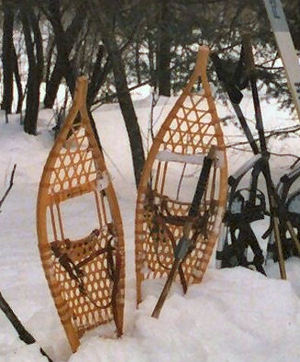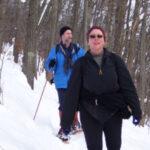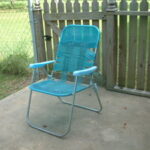In the 21st Century, aluminum, nylon, and space-age plastic snowshoes dominate the industry. But there are some good reasons to consider selecting traditional wooden snowshoes for winter exercise.
Any snowshoe outing will provide you with quality exercise. For a 150 pound adult, walking on snowshoes will burn anywhere from 450 to 840 calories an hour, depending on how packed the snow is, the terrain, and whether or not the walker uses poles. Using poles involves arm motion, and increases calorie usage. (Source American Hiker, December 2000)
Burning calories is usually a high priority for sedentary Americans, but there may be more subtle requirements for those who choose to take to the woods on snowshoes. I’ve been snowshoeing since the age of four, and have enough experience to suggest that my opinions are worthy of consideration.
If you savor the muffled quiet of a snowy morning, and enjoy listening for the sounds of birds or the snuff of a fox, then wooden snowshoes are for you. Without exception, the metal or plastic framed snowshoes are much noisier than wooden shoes. This will always be more noticeable where the snow is previously packed, but is a factor to consider in any kind of snow.
Many of the small modern snowshoes are poorly designed and will toss snow up your back with every step. If you are able to try out snowshoes before purchasing them, you could choose a pair that does not have this annoying drawback. Although there are some winter festivals where manufacturers and retailers allow people to try various models outdoors on real trails, trying out snowshoes in a store is not as simple as trying on a pair of boots.
One drawback of wooden snowshoes is that they do not have the crampons (small teeth) located under the ball of your foot to grab the snow or ice. Thus you would probably not choose wooden ones if you plan to do hilly off-trail snowshoeing, or ice crossings. However, for casual strolls on rolling terrain, the lack of these crampons is seldom a serious issue.
Finally, in a high-tech world, if you are one who seeks to return to a simpler time or life by venturing outdoors there is something comforting and mellow in the golden glow of varnished wooden snowshoes reflecting the flashes of light from your evening campfire. That joy alone can be worth owning a pair of traditional snowshoes.
So, you’ve decided that you’d like to own a pair of wooden snowshoes, but what should you look for?
First, consider which shape is best for you. There are three basic styles: Huron, Chippewa, and Bear Paw. The Huron or Maine shape is like a teardrop with an extended tail pointing toward the back. A variation on this shape is to make it very long and narrow, and this is sometimes called an Alaskan. Usually one long piece of wood is steamed and bent into this shape. This style is all-purpose, and the tail is designed to purposely provide a bit of drag in the rear to help lift the toe of the shoe out of the snow with each step you take. The Chippewa or Ojibway snowshoe is pointed in both the front and the back, and is usually made of two separate pieces of wood. This style is useful if you will be walking off-trail through areas with lots of brush. The pointed toe will easily slip between the stems of plants, while the tail performs the same function as in the Huron shoe. Bear Paw shoes are oval, or even round, with no tail at all. They are usually slightly wider than either of the other two styles. This design is for walking where you will be surrounded by many woody plants, such as thick saplings or dense woods. In this kind of situation the tail of the shoe is simply an annoyance rather than an aid.
Snowshoes don’t require the precise fitting that a pair of boots does, but there are some guidelines to keep in mind. Consider what it is that snowshoes are designed to do: keep you from sinking too deeply into the snow. Therefore, the more you weigh, the more surface area of decking (the webbing, or nylon that fills the space inside the frame of the snowshoe) you will need to spread out that weight.
Adult snowshoes range in length from about 42 to 60 inches. Their width is determined by how long the crossbars are (the pieces of wood that stretch the sides of the frame outward). Typical widths are 9 to 14 inches. When you choose a size, remember to add in the weight of the pack you will usually carry, if any. For example, if you plan to snowshoe for recreation and may just carry a daypack with some water and a dry jacket and mittens this is rather negligible. If you plan to spend time at a winter cabin with occasional walks to town to buy 30 pounds of groceries, or will be backpacking, this extra weight should be considered. Roughly speaking, snowshoes that are 10 x 48 are considered small, and are for weights of 100-140 pounds. 11 x 54 shoes are medium, for weights of about 130- 240 pounds, and larger shoes will support greater weights. Children’s snowshoes may be smaller, perhaps 8 x 36 inches.
For those who wish a slightly more quantitative way to assess their needs, you can calculate the square inches of decking the shoe provides. Multiply your total weight by 3 and allow for at least that much decking, also known as the floatation area.
Next you should look at the nearly square opening in the middle of the decking. If the snowshoes come fitted with a harness (the strapping that holds your foot to the snowshoe), this hole will be in front of the harness. The toe of your boot will need to move freely through this opening. Be sure that it is wide enough to accommodate the ball of your winter boots. You also need to be careful that this space is not too narrow from front to back. As you walk the toe of your boot will move through this space with each step. Some harnesses do not allow for much adjustment, and if your toe bangs on the front crossbar with each step your walk will be anything but enjoyable.
These basic elements should guide your wooden snowshoe selection. The type of material used for the decking, and the type of harness also should be considered. These topics will be covered in Part 2.
Reference:
- Snowshoeing by Gene Prater: books.google.com/books?id=sWUga1f11fEC




